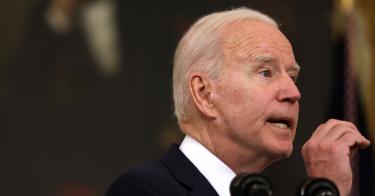The Biden administration is promoting its American Jobs Plan as an “infrastructure” proposal. In reality, it’s a gargantuan tax-and-spend package that would expand federal power and control in a wide variety of areas.
Although the plan is hyped as a path toward shared goals such as “jobs” and “global competitiveness,” a closer look reveals that it suffers from four core problems that completely undermine those goals.
Problem 1: Destructive tax hikes.
Just as the economy is pulling out of the pandemic recession, the plan would slam businesses with $2.7 trillion in tax increases over the next 15 years.
>>> 9 Things You Need to Know About Biden’s “Infrastructure” Spending Plan
This would reduce incentives for businesses to take risks in hiring new employees and make entrepreneurs less likely to take the biggest risk of all: starting a new enterprise. Over time that would have the effect of reducing economic growth, which means fewer jobs and lower wages.
In addition, the tax hike would cause America to have the second-highest rate for corporations among major economies after accounting for federal and state taxes. That would hamstring our economic competitiveness, directly contradicting one of the plan’s goals.
Problem 2: Federal infrastructure spending that fails to create jobs.
In order to create jobs, the plan would have to overcome the number of jobs destroyed by the tax increase. It would fall well short of just breaking even.
The infrastructure part of the plan follows the same failed path as the 2009 stimulus bill signed by President Barack Obama. A 2013 analysis of the Obama stimulus showed that the infrastructure-spending bump served to divert construction workers from private-sector projects to federal projects, meaning there was a minimal amount of job creation.
Further, federal regulations mean that these projects would have inflated costs for materials and labor, reducing the total number of projects and jobs tied to the spending.
Problem 3: Economically harmful central planning.
The plan would lead to more federal involvement in local infrastructure such as schools and water systems, and more micromanagement of private-sector concerns such as energy, manufacturing, housing and more.
In total, this would mean taking a huge amount of money (more than $20,000 per household) from the private economy and redistributing it toward politically favored interests.
History has repeatedly proven that greater government control of the economy leads to worse outcomes. The Heritage Foundation’s annual Index of Economic Freedom shows that countries with freer markets experience higher quality of life for metrics ranging from wages to personal health to the environment.
The health of America’s democracy would also take a turn for the worse if Washington gains even more say over local decisions. Local officials are more accountable to voters and more in tune with local needs and preferences than federal bureaucrats are.
Meanwhile, increasing the number of things Congress is responsible for overseeing would be a recipe for disaster regardless of who holds the reins of power. It would make federal elections even more bitter and winner-takes-all than they already are.
Problem 4: Wasteful infrastructure priorities and false advertising.
When federal officials reference infrastructure investments, the first thing that usually comes to mind is the quality of the nation’s highways and bridges, which carry countless amounts of both people and goods from coast to coast and border to border.
However, the Biden plan would only dedicate about 4% of its spending to highways and bridges. It would spend more on mass transit, which carries less than one-tenth as much passenger traffic as highways, and about as much on Amtrak, which was responsible for a microscopic 0.1% of travel in 2019.
>>> Why Joe Biden’s So-Called “Infrastructure” Plan Is a Mistake
Infrastructure projects grow the economy based only on how useful they are. The administration’s decision to prioritize transportation modes that aren’t a fit for America’s geography would lead to a tremendous amount of wasteful spending.
On top of the misguided infrastructure choices, the plan also includes massive amounts of spending that have nothing to do with infrastructure.
This includes hundreds of billions of dollars in corporate welfare, “green” slush funds, big subsidies for electric vehicles that will overwhelmingly benefit wealthy households, and a Medicaid benefit expansion. These provisions should stand or fall on their own, not hide behind popular terms like “infrastructure.”
In short, the “American Jobs Plan” would destroy rather than create jobs, harm rather than enhance global competitiveness, and waste huge sums on infrastructure. Congress would be better off using the proposal as a guide for what not to do.
This piece originally appeared in the Hastings Tribune



